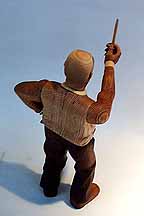Sagadahoc Stories 124: 3/6/01
Virgin Snow
3/6/01.. Virgin Snow.
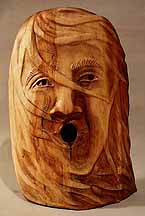
Storm Mask
|
It's been swirling snow for the last 36 hours and the white stuff
is now up to our own peculiarities. This has been a perfect winter,
if you like the sporting life. Even here on the coast the snow
hasn't melted since the first good fall in December, and there's
three foot of ice on the river and Bay. And at least that much
snow everywhere, right now. Hard on the deer, and the sugarers,
but splendid insulation around the house. And a good thing, too,
since the temperatures have been in the basement for the last
couple weeks, and the price of fuel unrepentant.
|
Aside from outdoor entertainments, I've put the season to good
use in the Eagles, and have the first real sense of momentum out
there I've had in years. It's curious how the work ebbs and flows,
even when the air is frozen. I'd like to pretend I have control
over it, but I'm more shuttlecock than racquet in this game.
Ever since I began peddling carvings on street corners there have
been three motivating factors which drove me. Creative inspiration,
promises made, and a desperate need for the legal tender. The
latter was pretty consistent, and I managed to attract enough
commissions to keep me at it steady, while the inspiration was
what made it all worth doing.
| But you can't call up the muse by Bell Atlantic, and I would stumble
through uninspired days in a state of angst and confusion. Of
course the best ideas come in mid flow, when your hands are engaged
and your feet dancing to the music, but getting there is hard,
if you depend on inspiration for ignition. That's where the desperation
and promises come in. |
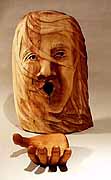
Puff
|
So what happens when the mortgage is paid off and you stop hustling
commissions? You'd have thought that the lack of external pressure
would pop my cork, and the good stuff come effervescing. Instead
of which the woodwork went completely flat for me. 'Course I
have more than one hat, just in case, and I've kept out of creative
trouble by drawing and painting and boatbuilding and writing and
webbing and whistling a tune.. but woodcarving is my calling,
like it or not. The only thing I'm really good at, and which really
eases the aginbite. I've been real busy the last few years avoiding
myself.
So what happened this winter? Maybe it was our brush with mortality.
The thought that this life is just a moment, and here I am fooling
around. I don't know what it is I have to say, but I do know what
medium I should be trying to say it in. I have no lack of ideas.
I have 30 years worth of ideas backed up. But I've always wanted
to work on TODAY'S idea. Ride the wave of new inspiration. And
today's flash made the necessary labor more appetizing. I got
hooked on enthusiasm as the prime motivation. All those old notions
were.. well.. old. Well: maybe I'm getting older, too. And maybe
I'm getting used to not being desperate, or over-committed. Maybe
I can take my enthusiasm in smaller doses.
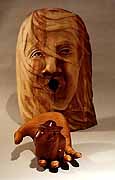
Hold your Hat
|
Whatever reason: I found myself out in the sawdust day after day
this season, and eager to be at it. Where I'd had trouble getting
enthused about any old ideas, I suddenly wanted to do them all.
Where I couldn't find enough charge for an isolated work, I now
have three series of works in progress, and I'm trying to hold
the horses. And (of course) I have commissions calling on the
phone. Ain't it always the way? Never snows but it blizzards.
|
Friday week I finished the first wall piece in my AMERICAN ICONS
series: the collection of culture heroes and iconic images I've
yammered about since Bering crossed the landbridge. I've decided
this one's called VIRGINIA. The collision of worlds embodied in
Captain John Smith and Pocahontas. She is a shamanic dancer, composed
in high relief, slipping through the swamp trees, beckoning. He
is in his Elizabethan armor, separate in three dimensions, holding
aloft the crossed hilt of his sword to ward off the unknown. The
early neolithic meets the late medieval. Their eyes are drawn
together.
| The image comes directly out of "A TRUE RELATION..", Smith's 1608
account of Jamestown's first year. Smith journeyed to Powhatan's
village to see the chief, but the men were all out hunting when
Smith's party arrived. The women sent for the hunters, and told
the English to be comfortable, and they would entertain them while
they waited. The ladies all disappeared in the woods. Then there
was a frightful uulation in the forest, and the English jumped
up and armed themselves, only to see the village women all dancing
out of the trees holding antlers to their brows. Doing a naked
deer dance. |
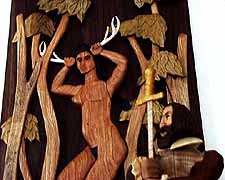
Close Up
|
This isn't the image we remember of Capt. Smith and Pocahontas,
of course. In that the teenage girl shields the captive Englishman
with her body from savage execution by her father. Smith didn't
tell that story until the fourth edition of TRUE RELATION, which
came out in 1617, by which time Pocahontas was married to John
Rolfe, had traveled to England, was the intimate of Queen Ann,
and the darling of King James' court. In fact that episode didn't
appear in any of the recorded accounts prior to 1617, or anyone
else's journal besides Smith's.
What did appear, in AN ACCOUNT OF THE STARVING TIME IN VIRGINIA,
by Master George Percy (a pamphlet published in 1614 to little
acclaim), was the account of the capture of the teenage boy Henry
Spelman by the Chicahominy, and how HE was saved by the timely
intervention of Pocahontas. John Smith knew how to use a good
tale, however.
[Modern ethnographers report that a ritual killing, halted at
the last minute by intercession of a tribeswoman, was a form of
symbolic adoption among the Chicahominy, but it's easy to imagine
the misunderstandings it might have caused.]
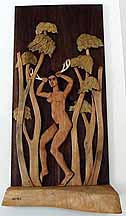
Deer Dance
|
Ironically, John Smith's life was probably less in need of embellishment
than any other biography of the time, but his compulsive need
to gild the lily convinced scholars (and the general public) that
he was a complete liar. The astonishing chronicle of his career,
which he published as THE TRUE TRAVELS, ADVENTURES, AND OBSERVATIONS
OF CAPTAINE JOHN SMITH, in 1730, was thought to be high fiction
until documents discovered in the 20th century confirmed the essence
of even his most outlandish claims. Smith is one of my heroes,
so I'll tell the gist of his tale.
|
Apprenticed to a merchant in Lincolnshire, young John Smith (17)
used the occasion of his father's death, and his small inheritance,
to plea for a sabbatical trip to France with the son of the local
lord. There, having been duped out of his funds in an attempt
to buy a commission in the Scots Guard, Smith threw up his expected
future, and join a ragtag band of mercenaries fighting under the
banner of King Henry IV of France, the greatest soldier-prince
of his day.
Smith stole his first horse and saddle in a raid, and won his
spurs in combat at the siege of Amiens, leading a foolhardy repulse
against a Spanish cavalry sortie, which bravery scattered a much
larger force. He made sergeant in a desperate harassment of relieving
troops breaking through to the beleaguered garrison. But when
Henry succeeded in choking off supplies to Amiens, the surrender
put Smith out of work.
| Sergeant Smith followed the mercenary band of his Captain, Joseph
Duxbury, into the service of Maurice of Nassau, Commander-in-chief
of the Dutch army, one of the most cunning tacticians of the age,
who was managing to defend his small nation by out-foxing the
vastly superior Spanish army. On July 1, 1600, Maurice attacked
the heavily fortified town of Nieuport, and by a ruse lured the
defenders into an exposed position. His mercenaries closed the
trap, and Maurice reported to the States-General: |
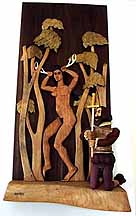
With John
|
"The paid horsemen rode in the van, and were inspired by the example
of an English sergeant in the the Duxbury company, one Jon Smyt
[sic], who laid about him with such rapid strokes that he left
a path of Spanish dead in his wake..." Smith was the only mercenary
mentioned in dispatches, but John was severely wounded by a pistol
shot at the tail end of the engagement.
The 21-year-old veteran was taken in by a grateful Nieuport merchant,
and convalesced there for 6 weeks, or until the merchant discovered
Smith bedding his eldest daughter (John describes her as "a fair
and buxom blond".. he had a thing for blonds), whereupon he was
tossed out in his nightshirt. He rejoined Duxbury's company, where
he was promoted to ensign and made third in command. He fought
cavalry skirmishes with the Spanish before Dunkirk until snow
fell in November, at which time the Spanish sued for peace, and
the mercenaries were disbanded. Maurice gave Smith a handsome
gift of gold coins for his services.
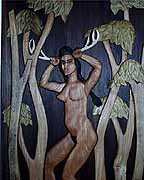
Close up
|
In the ensuing lull, Smith made the acquaintance of Peter Plancius,
the Dutch scholar who was the inspiration for many of that nation's
voyages of exploration, and a correspondent with Richard Hakluyt,
the intellectual inspirer of later English explorations. Plancius
taught Smith about world geography and mapping and gave him a
letter of introduction to Hakluyt when the young mercenary took
ship for home, anticipating a little R&R. |
Unfortunately, or fortunately, the ship he went aboard was storm-tossed
for a week, and had to put into the Channel Islands for repairs.
Which gave Smith time to become fast friends with the skipper,
one Henry Hudson. I told you the tale was too good to be true.
Even so the two dined repeated with Hakluyt, and all were mutually
impressed.
Smith bought a fine horse and splendid armor, and went home to
Lincolnshire, but he couldn't pick up the threads of that provincial
life. So the young hero retreated to a monastic solitude in his
lord's forest, where he lived in a cabin he built, and dined on
local game. Smith spent six months as a hermit, while he read
through the libraries of the local gentry, with particular attention
to the geographers and cartographers of the time.
| In July of 1601, rested and well-read, the young adventurer determined
to set out for central Europe where his old companions were fighting
the Turks, but his way there was serpentine, and full of hard-to-believe
incidents. He reported spending several months as a "guest" on
a Breton privateer in the Mediterranean, where her learned much
about the art of sailing, if not shipwreck, mutiny, and piracy.
In the winter of 1602 he landed in Naples, and went to Rome in
style, with considerably more money than he had set off with. |
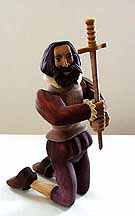
Capt. John Smith
(Click here for rotating Gif)
|
Smith claimed to have debated matters of theology with the Fathers
of the Society of Jesus at Rome, which claim amused scholars until
an account of these dialogues was uncovered among the Jesuit archives
in 1792.
John continued on until he met up with the army of Archduke Ferdinand
in the city of Graz, Austria, where they were mustering for an
assault on the Turks in Transylvania. Smith parlayed his letter
of introduction from the Jesuits, and his past record, into a
post as lieutenant on the personal staff of the Earl of Volda-Meldrich,
whom Smith called Meldri.
Meldri's artillery-augmented brigade marched into Transylvania
and Smith soon found that fighting the Turks was full of unorthodox
surprises, with no quarter given. In a close contest, Smith discovered
the advantages of the Janissarie's scimitars, and killing an opponent
for one, he replaced his sword with the Turkish weapon.
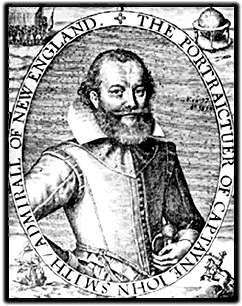
Self Portrait
|
Soon Lieutenant Smith was in the front lines at the siege of Alba
Regalis, a town near the Hungarian border, where he concocted
a scheme which gained the attention of his commanding lords. "Greek
fire" was a siege weapon of the time, a mixture of incendiary
ingredients set alight in wood-lined copper containers, which
were then catapulted into the fortifications to set the place
ablaze. Smith proposed that gunpowder mixed with hundreds of musket
bullets be added to the pot, and covered with heavy canvas, which
charge would ignite and explode on impact.
|
Fifty of these secret weapons were prepared and catapulted at
midnight into the quarter where the Turkish troops were most numerous.
The infantry followed up on the extensive carnage, and Alba Regalis
fell. The young lieutenant became Captain John Smith, and was
given a company of 250 men, mixed cavalry and infantry.
Capt. Smith fought his way into Transylvania where, Meldri reported,
"The company commanded by Capt. Smith has greater spirit than
any other in my corps, and will engage in any feat of daring."
John was about to prove the point before the walls of Orastie,
which stood in the way of the Christian advance. Unfortunately
Meldri was from Orastie, and the city was full of thousands of
Transylvania Christians, so it couldn't simply be devastated with
the new Greek fire. Worse yet, the Turkish commander was Suleiman,
the Sultan's younger brother, who dared not call for reinforcements
for political reasons. So the two forces sparred inconsequentially
at the walls of Orastie for several weeks, trading insults.
Finally a Turkish nobleman named Turbashaw had had enough, and
sent out a challenge under a flag of truce, calling for single
combat before the armies, and "the ladies of the city, who are
lacking the entertainments due to their station." Captain John
Smith demanded the honor of accepting.
| At noon the following day Turbashaw rode out of the city gates
in full Turkish pomp and encrusted armor. Smith entered the lists
in unornamented simplicity. When the starting pistols rang out
the contestants charged, and Smith's lance found its mark between
helmet and armor, killing Turbashaw. He then brandished his scimitar
and carried his opponent's head to his ruling prince, Sigismund
Bathory ("The Great Hungarian Bear"), ignoring with contempt Turbashaw's
armor and accouterments which were his rightful spoils. |
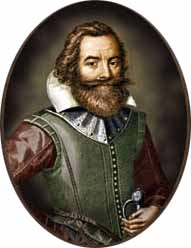
|
An outraged Turk, Gualgo, immediately demanded further satisfaction
on the following day, which challenge Smith accepted with condescending
disdain. The scene was repeated, this time Smith winning, after
breaking lances and trading pistol shots, with a swift decapitation.
The angry Turks resumed the battle, but Sigismund's forces still
held back from returning the fire, hoping to starve out the defenders
without harming the citizens. When secret messages came out of
the city reporting that food was almost gone, the point at which
Suleiman would have to send for reinforcements, Capt. Smith proposed
a delaying tactic. He would send in another insulting challenge,
then postpone the negotiations over details on various quibbles,
until the food situation was desperate.
Smith's message was to the Turkish ladies: "he was not so much
enamored of their servants' heads, but if any Turk of rank would
come to the place of combat to redeem them, he should have his
upon the like conditions, if he could win it." A Turkish Colonel
named Buenimolgri immediately responded. Smith called him Bonny
Mulgro.
The ruse continued for six days as Smith's seconds fussed the
details, but eventually had to settle on weapons: pistols, scimitars,
and battle-axes. Smith had no experience with the latter, but
he was rapidly drilled in its use, and faced his opponent the
next day at noon.
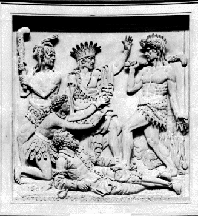
Iconic tale
|
This time the contest was uneven, Bonny Mulgro was a giant of
a man, and the opponents' first round of pistol shots went wide.
The Turk then attacked Smith with his ax, and they traded blows
until Smith was stuck upside the head and half-unhorsed. But in
his eagerness to strike the killing blow, Bonny Mulgro exposed
his neck, and Smith dropped his ax and slashed him with his scimitar,
killing yet another challenger. The fans went wild.
|
The delay had done the trick, the city was out of food, and after
two Turkish messengers were captured seeking reinforcements, and
sent back into the city, Suleiman surrendered. Smith was the hero
of the hour, and Sigismund promoted him to major, gave him a battalion
of 700 men. Which troops were constantly in the vanguard as Christian
forces stuck deeply toward Bulgaria. Unwisely deep, as it turned
out, when Meldri and Smith became separated from Sigismund's main
force, and were trapped in the Oltu Valley by Crimean Tartars
along with Turkish Janissaries and Dragoons. Their defensive position
was over-run and Smith reported "the slaughter was frightful."
Meldri's forces were destroyed. Major Smith was knocked unconscious
on the field, and taken captive when later discovered to be still
alive.
Stripped naked, the Christian captives were marched off into slavery.
At Tchernavoda the prisoners were sold in the slave market, where
a pasha named Timor bought Smith for three gold coins. The pasha
eventually had Smith taken to Constantinople by his eunuchs, where
he was given as a present to his mistress, the Lady Charatza Tragabigzanda.
Smith expected to experience the fate of other male prisoners,
but wasn't emasculated by the pasha's mistress, as it was currently
fashionable to be waited on by a real male dressed as a lady's
maid.
Apparently John more than waited on the lady, and he also made
a secret alliance with another of her waiting women, an English
girl named Elizabeth Rondee. The fact that Elizabeth was a beautiful
blond, and milady a fair Turk, might have had something to do
with it. Even so, Charatza jealously sent Elizabeth away as a
gift to a Morrocan relative, and eventually had to part company
with Capt. Smith, after her mother got wind of things, and began
to make a fuss.
To cover their tracks, Charatza sent Smith to the pasha at his
estates in Cambria, on the Black Sea, saying she was bored with
him. Timor immediately put a slave ring around Smith's neck, and
set him to doing menial labor in the fields. Smith had been a
slave for more than a year when Timor happened to catch him asleep
in a barn during threshing time. The pasha began slashing him
with a riding crop, and Smith revolted, beating Timor to death
with a threshing-bat. Luckily the pasha was alone, and Smith stole
his his clothes, weapons, and horse, and made off toward the Russian
border.
| After a series of hair-raising encounters, our hero managed to
find his was to Rostov, an outpost of Tsar Boris Gudunov's kingdom,
where he was taken prisoner, and delivered before Baron Reshdinski,
the Tsar's governor, for interrogation. Reshdinski was a bored
intellectual stuck in the provinces (as well as a blood-thirsty
tyrant), and he took an immediate liking to Smith with whom he
shared linguistic interests, and the governor took John under
his wing. |
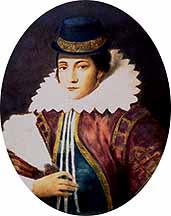
Pocahontas in England
|
As it happened, Reshdinski had a willowy blond niece, the Lady
Camallata. Wouldn't you know it? Who became the (unrequited) love
of Smith's life. Well-educated, Camallata could trade witticisms
with John in French and Latin, and she taught him Russian to pass
the time. In late Spring, 1604, Smith and Camallata joined a trade
caravan to Moscow, where Smith was virtually held captive by Gudonov's
xenophobia. John asked Camallata to return to England with him
as his wife, but she demurred. Capt. Smith set off for the west,
alone, only to find a universal peace had been declared.
The wandering adventurer finally caught up with Sigismund in Leipzig,
where he was hailed as a hero, wined and dined, presented with
a coat of arms, bags of gold, and a passport good throughout Europe.
John began a leisurely tour of Christendom which took him through
Italy, France and Spain, culminating in Cadiz in the summer of
1605.
It was there that John Smith took ship with eight retainers on
a Spanish privateer under a Captain Cordoba. In September the
ship arrived in El Araish, where the pasha Mahomet ben Arif, lived
in the fortress, along with his family and their slaves, including
Elizabeth Rondee. Dressed as a great lord, and surrounded by his
attendants, all wrapped in heavy furs, Smith informed the harbormaster
that he had brought gifts for the pasha, and wished to pay his
respects.
When brought before Mahomet, Smith continued the charade, offering
the pasha an expensive ring, and singing his praise in Turkish.
After the usual amenities, John turned the talk around to slaves,
and remarked that he'd heard the pasha actually had a blond waitingservant,
but that he didn't believe such fables. With more encouragement,
Mahomet was lured into calling for Elizabeth. John engaged he
in conversation in English, and the pasha, guessing something
was up, rose to call the guard. Smith immediately dispatched him,
and John's entourage threw off their furs, exposing their armor
and weapons, and quickly overcame the guards.
After a slapstick chase scene, Smith managed to escape with
the loss of only one man, and Elizabeth was carried back to Cadiz in the arms
of her savior. The pair eventually found their way to England on a Portuguese
bark, creating a sensation upon their arrival. Capt. John was the toast of the
town in London, and proceeded to mix with the royals and other who's whos. His
gifts of charming and affronting people were on full display, and when the London
Company was chartered by King James under the guidance of Hakluyt, Smith was
easily enrolled among the gentlemen adventurers who would sail to Virginia.
When the SUSAN CONSTANT sighted land, on April 27, 1607, Captain John Smith
was all of 26 years old.
If that isn't enough gist for a great movie, what is? By the time of the Virginia
experiment Capt. John Smith was a trained leader of men in adversity, used to
living rough and fighting against unorthodox foes with any weapons, in addition
to being a master linguist and cartographer. The necessary man of the hour.
I can thank THE GREAT ROGUE, by Paul Lewis, for much of this tale, and I recommend
you to Smith's own writings as the first and foremost examples of American public
relations. Not only did Smith invent the name New England, to lure colonists,
but he was the first to advertise these shores as the place that anyman could
rise to his true estate. A hero for everyman.
| |
NOTE: I have been informed by
John Sutton who gives tours at Jamestown that at least part of this account
is fictional (that concerning Elizabeth Rondee). My source [The
Great Rogue; a biography of Captain John Smith, by Paul Lewis]
turns out to have been as inventive as Smith himself. So take all this with
a grain of salt. Thanks, John. |
|
| After I finished VIRGINIA, I had the chance to honor another of
my heroes, this one more contemporary. Herb Abrams, the portrait
painter who has been an inspiration and model for me since my
infancy, turns 80 this month, and I decided it was time to do
a portrait of the artist.. as a younger man. The most recent pictures
I have of Herb are twenty years old. But the gesture he is making
is timeless: he's taking our measure (by holding a paintbrush
at arm's length as an index), and the hipshot stance is, I hope,
Whitmanesque. |
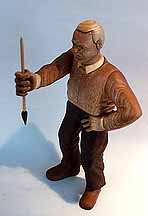
Taking our Measure
(Click here for rotating Gif)
|
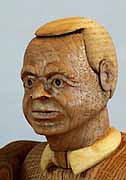
|
Herb has followed his star, without deviation, since 1946, and
is now one of this country's foremost portraitists. Considering
that portrait painting was the first American art form, and along
with abstract expressionism, modern dance, movies, blues and jazz,
is still the most American of arts, that puts Herb up there with
the Duke and Miles. It was a joy to go give the carving to Herb,
one of my masters. |
A whiteout is a fine time to sit by the fire and tell tales. Now
it's time to go dig out.
